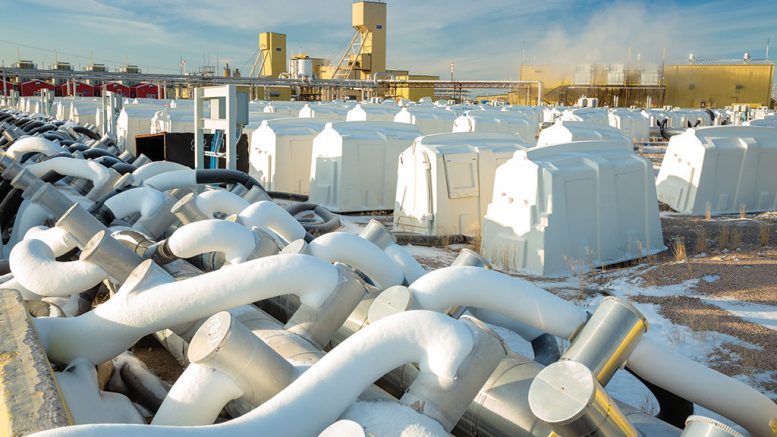While uranium spot prices were down 14% in 2019, supply and demand fundamentals for uranium are the “most bullish in years,” and the sector “offers its most compelling value proposition since pre-Fukushima,” Haywood Securities said in a Jan. 29 research note.
“Looking ahead, we believe we are in the early stages of a long-term bull market for the uranium investment theme and recommend investors begin positioning their portfolios by steadily accumulating select names,” it said. “Previously enacted and expected major supply cuts are starting to erode global inventories with primary production now less than reactor demand.”
Haywood forecasts the average spot price for U308 will increase from US$26 per lb. last year to US$39 per lb. in 2020, and continue rising to US$47 per lb. (2021), US$55 per lb. (2022), US$64 per lb. in 2023 and to US$65 per lb. in 2024 and 2025. The long term price is expected to move from US$32 per lb. in 2019 to US$46 per lb. this year and then increase to US$55 per lb. (2021), US$63 per lb. (2022), US$70 (2023), after which it will remain steady at US$65 per lb. in 2024 and 2025.
“While 2019 failed to deliver the more substantial increase in uranium benchmark prices we anticipated, we still believe the fundamentals of the sector have dramatically improved over the last 18–24 months and that we are near the beginning of the next utility buying cycle.”
Haywood also noted that the global reactor pipeline remains robust and is nearing the number prior to the Fukushima nuclear plant disaster in Japan.
“Importantly, the number of operating reactors is inching ever close to the pre-Fukushima era as Japan made significant strides to bring reactors back online over the last two years,” the report stated. “‘Reactors under construction’ have declined slightly since January 2011, but there is an underlying success story here that keeps us bullish. Since 2014, China has completed construction on and commissioned 28 reactors, increasing its operating fleet to 47 (+161% in just five years). China makes up 21% (911 units) of the current global ‘under construction’ pipeline, with another seven in India, four in Russia, four in South Korea and four in the United Arab Emirates.”

Uranium Energy’s Palangana in-situ recovery uranium mine in south Texas. Credit: Uranium Energy.
Haywood puts the current reactor fleet globally at 415 operating reactors and expects demand growth of about 26% in ‘operating’ reactors from 415 today to 520 by 2035.
In the U.S., Haywood noted that uranium production saw declines in the double digits annually in the last five-year period, falling from 5 million lb. U3O8 in 2014 to 1 million lb. U3O8 in 2019, “representing a tiny fraction of the country’s annual reactor demand, which is approaching 50 million lb. U3O8 a year.
“Substantially higher prices will be required to incentivize new mine construction to backfill the accelerating supply shortfall we outline from 2027,” Haywood stated.
Haywood also argued that uranium equities “will lead the charge higher in anticipation of higher uranium prices.”
It recommends core uranium holdings of Cameco (TSX: CCO; NYSE: CCJ); Denison Mines (TSX: DML); Energy Fuels (TSX: EFR; NYSE AM: UUU); NexGen Energy (TSX: NXE); Uranium Energy (NYSE AM: UEC); Uranium Participation (TSX: U); and Azarga Uranium (TSX: AZZ).
Among the group its top picks are NexGen and Azarga Uranium.
“NexGen controls the best uranium discovery made anywhere in the world in decades, in the ultra-high-grade Arrow deposit, while Azarga has made major project level and regulatory progress in 2019 and we expect it can convert this success into share price performance in 2020.”
Both companies would make attractive acquisition targets, Haywood reasoned.
In terms of NexGen’s Arrow deposit, Haywood said, “it is critical for existing major producers to control this deposit because of its disruptive potential,” and pointed to a prefeasibility study outlining cash operating costs of US$4.65 per pound.
As for Azarga, it said its Dewey Burdock project has “potential to evolve into a lower cost, low CAPEX uranium producing operation in the U.S.” and pointed to a preliminary economic assessment in December 2019 outlining a pre-tax net present value at an 8% discount rate of US$63 million and internal rate of return of 28% at a uranium price of US$40 per pound.
“With all-in pre-tax cost of production of US$29 per lb., Dewey Burdock should be a very resilient project capable of generating positive cash-flow even at currently depressed long-term market prices.”


Be the first to comment on "Haywood bullish on uranium sector fundamentals"